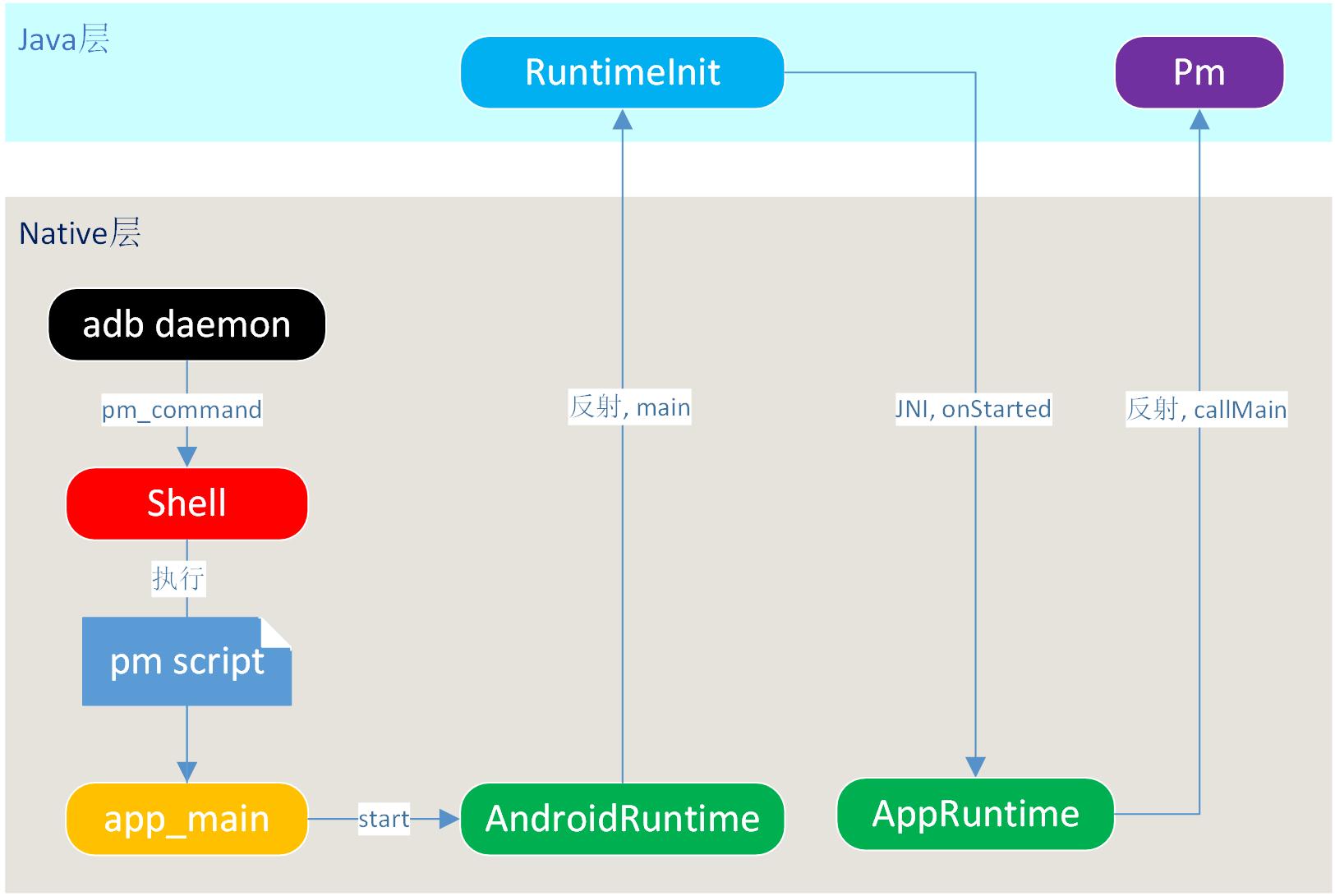在本篇博客中,我们分析一下Android中的APK是如何安装的,以及PKMS在这个过程中进行了哪些工作。
APK的安装方式有很多,我们先来看看如何用adb命令进行安装。
我们从adb install开始分析,该命令有多个参数,这里仅考虑最基本的adb install xxxx.apk。
一、adb命令
看看system/core/adb/commandline.cpp中的adb_commandline函数:
int adb_commandline(int argc, const char **argv) {
...........
else if (!strcmp(argv[0], "install")) {
if (argc < 2) return usage();
FeatureSet features;
std::string error;
if (!adb_get_feature_set(&features, &error)) {
fprintf(stderr, "error: %s\n", error.c_str());
return 1;
}
if (CanUseFeature(features, kFeatureCmd)) {
//支持FeatureCmd时调用install_app
return install_app(transport_type, serial, argc, argv);
}
//否则,利用install_app_legacy
return install_app_legacy(transport_type, serial, argc, argv);
}
...........
}1、install_app_legacy
我看先看看传统的install_app_legacy:
static int install_app_legacy(TransportType transport, const char* serial, int argc, const char** argv) {
//待安装的APK目前还在源机器上,现在需要把APK的文件复制到手机里
//如果安装在手机内部存储,那么目的地址为DATA_DEST
//如果安装在SD卡上,则目的地址为SD_DEST
static const char *const DATA_DEST = "/data/local/tmp/%s";
static const char *const SD_DEST = "/sdcard/tmp/%s";
.........
//默认安装到手机内部
const char* where = DATA_DEST;
for (i = 1; i < argc; i++) {
//携带参数-s时,才安装到SD卡
if (!strcmp(argv[i], "-s")) {
where = SD_DEST;
}
}
//解析参数,判断adb命令中是否携带了有效的apk文件名
...........
//取出apk名
std::vector<const char*> apk_file = {argv[last_apk]};
//构造apk目的地址
std::string apk_dest = android::base::StringPrintf(
where, adb_basename(argv[last_apk]).c_str());
//do_sync_push将此APK文件传输到手机的目标路径,失败的话将跳转到clenaup_apk
if (!do_sync_push(apk_file, apk_dest.c_str())) goto cleanup_apk;
//执行pm_command
result = pm_command(transport, serial, argc, argv);
cleanup_apk:
//删除刚才传输的文件
//PKMS在安装过程中会将该APK复制一份到/data/app目录下,所有data/local/tmp目录下对应的文件可以删除
delete_file(transport, serial, apk_dest);
return result;
}从代码来看,传统的安装方式就是将源机器中的APK文件拷贝到目的手机的tmp目录下,然后调用pm_command进行处理。
2、install_app
我们再看看支持FeatureCmd的机器,如何安装APK:
static int install_app(TransportType transport, const char* serial, int argc, const char** argv) {
//利用参数创建出本地文件的名称
const char* file = argv[argc - 1];
//解析参数,判断adb命令中是否携带了有效的apk文件名
.........
//adb_open中将创建出这个file对应的文件
int localFd = adb_open(file, O_RDONLY);
............
std::string cmd = "exec:cmd package";
//添加cmd参数
............
//连接源端,获取源APK文件的描述符
int remoteFd = adb_connect(cmd, &error);
............
//将remoteFd中的数据写入到localFd
copy_to_file(localFd, remoteFd);
//得到结果
read_status_line(remoteFd, buf, sizeof(buf));
adb_close(localFd);
adb_close(remoteFd);
..........
return 0;
}从代码来看install_app就是将源机器的文件复制到了目的机器中,并没有进行额外的操作。猜想可能是支持特殊FeatureCmd的机器,PKMS能够监听到这个拷贝,然后触发后续的扫描工作。这个过程没有研究过对应代码,暂时不做深入分析。
对于传统的安装方式,我们需要继续往下看看pm_command。
二、pm_command
我们先看看pm_command函数:
static int pm_command(TransportType transport, const char* serial, int argc, const char** argv) {
std::string cmd = "pm";
//构造pm cmd
while (argc-- > 0) {
cmd += " " + escape_arg(*argv++);
}
//发送shell命令给adbd
return send_shell_command(transport, serial, cmd, false);
}我们跟进下send_shell_command:
// Connects to the device "shell" service with |command| and prints the
// resulting output.
static int send_shell_command(TransportType transport_type, const char* serial,
const std::string& command,
bool disable_shell_protocol,
std::string* output=nullptr,
std::string* err=nullptr) {
...........
while (true) {
bool attempt_connection = true;
// Use shell protocol if it's supported and the caller doesn't explicitly disable it.
if (!disable_shell_protocol) {
.......
if (adb_get_feature_set(&features, &error)) {
//如果定义了feature,则替换shell protocol
use_shell_protocol = CanUseFeature(features, kFeatureShell2);
} else {
// Device was unreachable.
attempt_connection = false;
}
}
if (attempt_connection) {
std::string error;
//此时command中携带的就是以pm开头的命令
std::string service_string = ShellServiceString(use_shell_protocol, "", command);
//向shell服务发送命令
fd = adb_connect(service_string, &error);
if (fd >= 0) {
break;
}
}
............
}
//读取返回结果
int exit_code = read_and_dump(fd, use_shell_protocol, output, err);
if (adb_close(fd) < 0) {
..........
}
return int exit_code;
}从上面的代码来看,pm_command就是向shell服务发送pm命令。
pm是一个可执行脚本,我们在终端上调用adb shell,然后执行pm,可以得到以下结果:
root:/ # pm
usage: pm list packages [-f] [-d] [-e] [-s] [-3] [-i] [-u] [--user USER_ID] [FILTER]
pm list permission-groups
pm list permissions [-g] [-f] [-d] [-u] [GROUP]
pm list instrumentation [-f] [TARGET-PACKAGE]
..........pm脚本定义在frameworks/base/cmds/pm中:
base=/system
export CLASSPATH=$base/framework/pm.jar
exec app_process $base/bin com.android.commands.pm.Pm "$@"在编译system.img时,会根据Android.mk将该脚本复制到system/bin目录下。
从脚本的内容来看,当调用pm时,将向app_process目录的main函数传入Pm对应的参数:
我们看看对应的定义于app_main.cpp的main函数(前面的博客分析过,这个其实也是zygote启动的函数):
//app_process的main函数
int main(int argc, char* const argv[]) {
........
//解析参数
while (i < argc) {
const char* arg = argv[i++];
if (strcmp(arg, "--zygote") == 0) {
zygote = true;
niceName = ZYGOTE_NICE_NAME;
} else if (strcmp(arg, "--start-system-server") == 0) {
startSystemServer = true;
} else if (strcmp(arg, "--application") == 0) {
application = true;
} else if (strncmp(arg, "--nice-name=", 12) == 0) {
niceName.setTo(arg + 12);
} else if (strncmp(arg, "--", 2) != 0) {
//此时我们有参数,进入该分支设置className
className.setTo(arg);
break;
} else {
--i;
break;
}
}
...........
if (zygote) {
runtime.start("com.android.internal.os.ZygoteInit", args, zygote);
} else if (className) {
//此时不再是启动zygote,而是启动className对应的类
runtime.start("com.android.internal.os.RuntimeInit", args, zygote);
} else {
.........
}
........
}我们跟进AndroidRuntime.cpp的start函数:
void AndroidRuntime::start(const char* className, const Vector<String8>& options, bool zygote)
{
..........
jmethodID startMeth = env->GetStaticMethodID(startClass, "main",
"([Ljava/lang/String;)V");
if (startMeth == NULL) {
ALOGE("JavaVM unable to find main() in '%s'\n", className);
} else {
//反射调用main函数,从native层进入java世界
env->CallStaticVoidMethod(startClass, startMeth, strArray);
}
.........
}于是流程会进入到RuntimeInit的main函数:
public static final void main(String[] argv) {
........
//进行一些常规的初始化工作
commonInit();
/*
* Now that we're running in interpreted code, call back into native code
* to run the system.
*/
nativeFinishInit();
.........
}native函数定义在framework/base/core/jni/AndroidRuntime.cpp中,对应的函数为:
static void com_android_internal_os_RuntimeInit_nativeFinishInit(JNIEnv* env, jobject clazz)
{
//gCurRuntime保存AndroidRuntime,实际上是AndroidRuntime的子类
gCurRuntime->onStarted();
}App_main.cpp中定义的AppRuntime继承AndroidRuntime,实现了onStarted函数:
virtual void onStarted()
{
//binder通信相关的
sp<ProcessState> proc = ProcessState::self();
ALOGV("App process: starting thread pool.\n");
proc->startThreadPool();
AndroidRuntime* ar = AndroidRuntime::getRuntime();
//调用AndroidRuntime.cpp的callMain函数,参数与Pm.java相关
ar->callMain(mClassName, mClass, mArgs);
IPCThreadState::self()->stopProcess();
}status_t AndroidRuntime::callMain(const String8& className, jclass clazz,
const Vector<String8>& args) {
..........
env = getJNIEnv();
..........
methodId = env->GetStaticMethodID(clazz, "main", "([Ljava/lang/String;)V");
..........
const size_t numArgs = args.size();
stringClass = env->FindClass("java/lang/String");
strArray = env->NewObjectArray(numArgs, stringClass, NULL);
for (size_t i = 0; i < numArgs; i++) {
jstring argStr = env->NewStringUTF(args[i].string());
env->SetObjectArrayElement(strArray, i, argStr);
}
...........
//最终调用了Pm.java的main函数
env->CallStaticVoidMethod(clazz, methodId, strArray);
return NO_ERROR;
}这里自己初次看时,认为这里没有fork新的进程,那么APK安装运行在zygote进程中。
实际上这是一个错误的理解,说明自己的理解还不到位。
init创建zygote进程时,是fork出一个子进程,然后才调用app_main中的函数,此时整个zygote严格来讲只是一个native进程;当app_main函数最终通过AndroidRuntime等反射调用zygoteInit.java的main函数后,才演变成了Java层的zygote进程。
这里的情况是类似的,adb进程发送消息给Shell服务,Shell服务执行Pm脚本,由于exec函数并未创建出新的进程,因此调用app_main后整个代码仍然是运行在Shell服务对应的native进程中,同样通过反射后演变为Java层中的进程。
这里自己花了很多的笔墨来分析如何从执行脚本文件,到启动Java进程。
主要是弄懂这个机制后,我们实际上完全可以学习pm的写法,依葫芦画瓢写一个脚本文件,然后定义对应的Java文件。
通过脚本命令,来让Java层的进程提供服务。
最后,我们通过一个图来总结一下这个过程:
三、Pm中的流程
现在我们进入了Pm.java的main函数:
public static void main(String[] args) {
int exitCode = 1;
try {
//别被写法欺骗了,Pm并没有继承Runnable
exitCode = new Pm().run(args);
} catch (Exception e) {
.......
}
System.exit(exitCode);
}
//根据参数进行对应的操作,现在我们仅关注APK安装
public int run(String[] args) throws RemoteException {
...........
//利用Binder通信,得到PKMS服务端代理
mPm = IPackageManager.Stub.asInterface(ServiceManager.getService("package"));
//保存参数
mArgs = args;
String op = args[0];
mNextArg = 1;
............
//返回PKMS中保存的PackageInstallerService
mInstaller = mPm.getPackageInstaller();
........
if ("install".equals(op)) {
//安装APK将调用runInstall
return runInstall();
}
.......
}我们跟进runInstall函数:
private int runInstall() throws RemoteException {
//根据参数创建InstallParams,其中包含了SessionParams,标志为MODE_FULL_INSTALL
final InstallParams params = makeInstallParams();
//1 创建Session
final int sessionId = doCreateSession(params.sessionParams,
params.installerPackageName, params.userId);
try {
//inPath对应于安装的APK文件
final String inPath = nextArg();
.......
//2 wirite session
if (doWriteSession(sessionId, inPath, params.sessionParams.sizeBytes, "base.apk",
false /*logSuccess*/) != PackageInstaller.STATUS_SUCCESS) {
return 1;
}
//3 commit session
if (doCommitSession(sessionId, false /*logSuccess*/)
!= PackageInstaller.STATUS_SUCCESS) {
return 1;
}
System.out.println("Success");
return 0;
} finally {
........
}
}从上面的代码来看,runInstall主要进行了三件事,即创建session、对session进行写操作,最后提交session。
接下来,我们来看看每一步究竟在干些什么:
1、 create session
private int doCreateSession(SessionParams params, String installerPackageName, int userId)
throws RemoteException {
//通过ActivityManagerService得到"runInstallCreate"(作为Context对应的字符串)对应的uid
userId = translateUserId(userId, "runInstallCreate");
if (userId == UserHandle.USER_ALL) {
userId = UserHandle.USER_SYSTEM;
params.installFlags |= PackageManager.INSTALL_ALL_USERS;
}
//通过PackageInstallerService创建session
final int sessionId = mInstaller.createSession(params, installerPackageName, userId);
return sessionId;
}跟进一下PackageInstallerService的createSession函数:





 本文深入剖析了Android7.0中APK的安装过程,从adb install命令开始,详细解释了adb命令如何调用PM服务,以及PM服务如何通过PackageInstallerSession进行文件拷贝和权限检查,最终如何调用PKMS完成安装。文章还探讨了Binder通信、安装阶段的处理和实际安装工作的服务DefaultContainerService的角色。
本文深入剖析了Android7.0中APK的安装过程,从adb install命令开始,详细解释了adb命令如何调用PM服务,以及PM服务如何通过PackageInstallerSession进行文件拷贝和权限检查,最终如何调用PKMS完成安装。文章还探讨了Binder通信、安装阶段的处理和实际安装工作的服务DefaultContainerService的角色。

 最低0.47元/天 解锁文章
最低0.47元/天 解锁文章
















 2772
2772

 被折叠的 条评论
为什么被折叠?
被折叠的 条评论
为什么被折叠?








